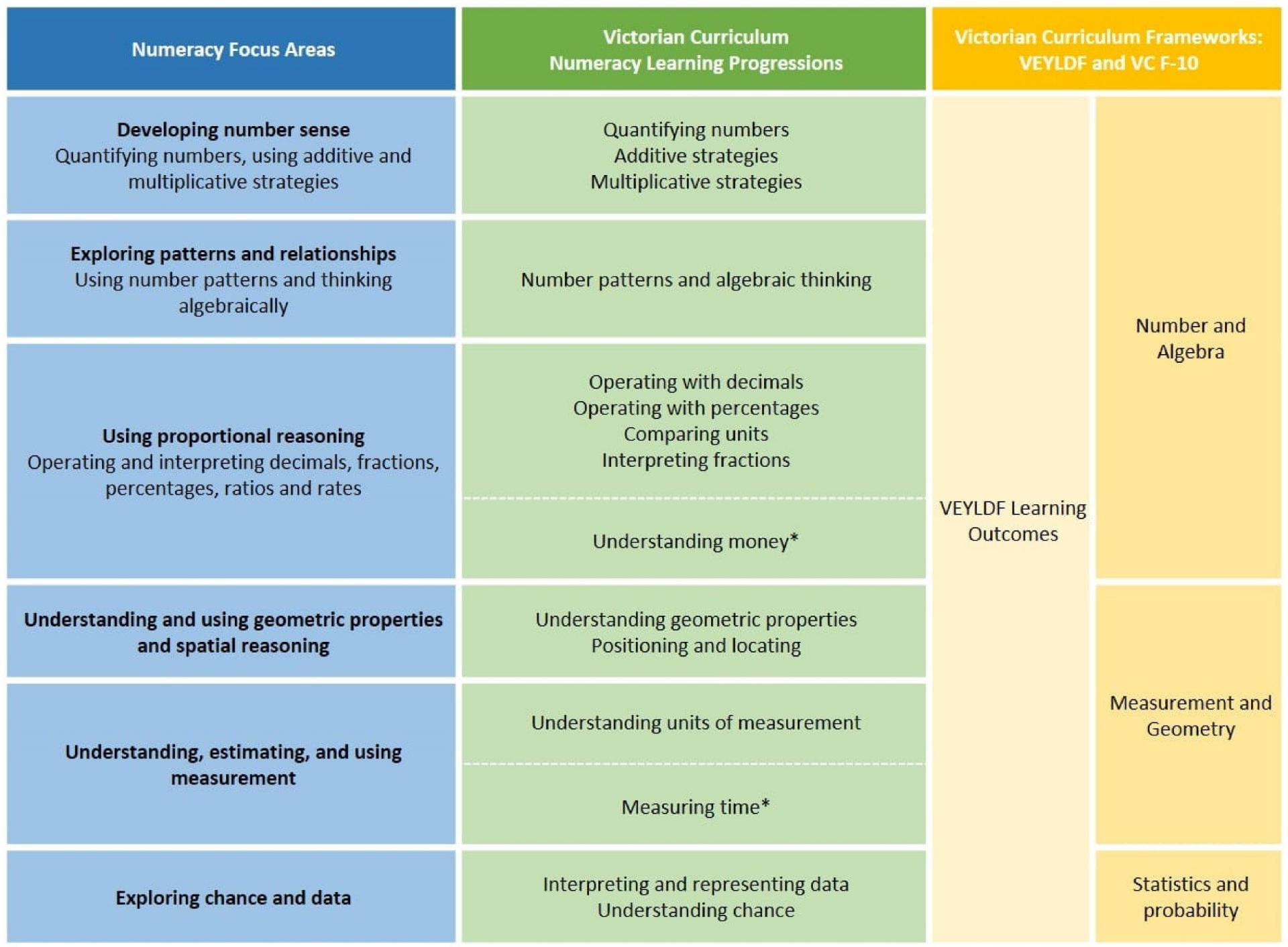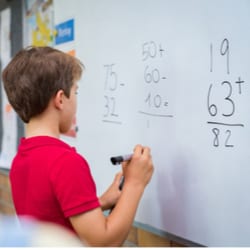Numeracy Focus Areas
Discover numeracy through six numeracy focus areas, developed from the Victorian Numeracy Learning Progressions and numeracy research.
Context for the Numeracy Focus Areas
The Numeracy Focus Areas are based on the definition of numeracy adopted by the Victorian Department of Education and Training and more broadly on the model for twenty-first century numeracy developed by Goos (2011), with explicit links to:
Click on the '+' to expand the box and read more about each statement
The six Numeracy Focus Areas
The Numeracy Focus Areas are six key numeracy components that provide an overview of numeracy from Birth to Level 10. The six focus areas are:
- Developing number sense (Quantifying numbers, using additive and multiplicative strategies)
- Exploring patterns and relationships (Using number patterns and thinking algebraically)
- Using proportional reasoning (Operating and interpreting decimals, fractions, percentages, ratios and rates)
- Understanding and using geometric properties and spatial reasoning
- Understanding and using measurement
- Exploring chance and data
Within each Numeracy Focus, we describe:
- The mathematical concepts, knowledge and skills that underpin the component
- Examples and everyday contexts where the numeracy focus may be used or identified
- Language that may be used to make the numeracy focus
explicit
The six Numeracy Focus Areas provide a common and shared language for all Victorian educators as a way to support and improve communication of key aspects of numeracy learning.
To learn more about the multi-faceted nature of numeracy, see the section on Numeracy in the twenty-first century in the Evidence base.
Relationship to the Victorian Numeracy Learning Progressions and the Proficiencies
Each numeracy focus is drawn from the Victorian Numeracy Learning Progressions and numeracy research. The Numeracy Learning Progressions outline a sequence of indicators of increasingly sophisticated understanding and skills in numeracy. The Victorian Numeracy Learning Progressions can be used as a tool to facilitate a deeper understanding of numeracy development.
The four proficiencies – understanding, fluency, problem-solving and reasoning – are woven into the descriptions of each Numeracy Focus and made explicit through the use of language and examples that may be used to develop them.
To learn more about the effective teaching of numeracy, see the section on Developing a capacity to teach numeracy in the Evidence Base.
Organisation and mapping of the Numeracy Focus Areas
The Numeracy Focus Areas are organised to demonstrate and foster the interconnectedness of numeracy and mathematics with students’ lives.
The table below explicitly acknowledges the alignment of, and relationship between, the Numeracy Focus Areas and the Victorian Numeracy Learning Progressions, the Victorian Curriculum frameworks and the Australian Curriculum: Numeracy capability.
Furthermore, the Numeracy Focus Areas reflect key ideas that are shared across wider national and international frameworks and theories, including the Australian Curriculum Numeracy capability, the Tasmanian Numeracy Guides, the National Numeracy and Mathematics Progression Framework Scotland and contemporary research (see the Evidence base section of the Numeracy Guide, e.g. Goos, Geiger, Dole, Forgasz, & Bennison, 2019).
The Numeracy Focus Areas for chance and data have not been separated, but rather have been addressed and aligned to Interpreting statistical information in the Australian Curriculum: Numeracy capability (ACARA).
The Numeracy Focus Areas synthesise contemporary evidence-based thinking in the field.
Click on the '+' to expand the box and read more about each statement
The six Numeracy Focus Areas
The Numeracy Focus Areas are six key numeracy components that provide an overview of numeracy from Birth to Level 10. The six focus areas are:
- Developing number sense (Quantifying numbers, using additive and multiplicative strategies)
- Exploring patterns and relationships (Using number patterns and thinking algebraically)
- Using proportional reasoning (Operating and interpreting decimals, fractions, percentages, ratios and rates)
- Understanding and using geometric properties and spatial reasoning
- Understanding and using measurement
- Exploring chance and data
Within each Numeracy Focus, we describe:
- The mathematical concepts, knowledge and skills that underpin the component
- Examples and everyday contexts where the numeracy focus may be used or identified
- Language that may be used to make the numeracy focus
explicit
The six Numeracy Focus Areas provide a common and shared language for all Victorian educators as a way to support and improve communication of key aspects of numeracy learning.
To learn more about the multi-faceted nature of numeracy, see the section on Numeracy in the twenty-first century in the Evidence base.
Relationship to the Victorian Numeracy Learning Progressions and the Proficiencies
Each numeracy focus is drawn from the Victorian Numeracy Learning Progressions and numeracy research. The Numeracy Learning Progressions outline a sequence of indicators of increasingly sophisticated understanding and skills in numeracy. The Victorian Numeracy Learning Progressions can be used as a tool to facilitate a deeper understanding of numeracy development.
The four proficiencies – understanding, fluency, problem-solving and reasoning – are woven into the descriptions of each Numeracy Focus and made explicit through the use of language and examples that may be used to develop them.
To learn more about the effective teaching of numeracy, see the section on Developing a capacity to teach numeracy in the Evidence Base.
Organisation and mapping of the Numeracy Focus Areas
The Numeracy Focus Areas are organised to demonstrate and foster the interconnectedness of numeracy and mathematics with students’ lives.
The table below explicitly acknowledges the alignment of, and relationship between, the Numeracy Focus Areas and the Victorian Numeracy Learning Progressions, the Victorian Curriculum frameworks and the Australian Curriculum: Numeracy capability.
Furthermore, the Numeracy Focus Areas reflect key ideas that are shared across wider national and international frameworks and theories, including the Australian Curriculum, the Tasmanian Numeracy Guides, the National Numeracy and Mathematics Progression Framework Scotland and contemporary research (see the Evidence base section of the Numeracy Guide, e.g. Goos, Geiger, Dole, Forgasz, & Bennison, 2019).
The Numeracy Focus Areas for chance and data have not been separated, but rather have been addressed and aligned to Interpreting statistical information in the Australian Curriculum: Numeracy capability (ACARA).
The Numeracy Focus Areas synthesise contemporary evidence-based thinking in the field.
The six Numeracy Focus Areas
Click on the tiles to read a general overview of each focus area and then explore what it looks like at each developmental stage.










